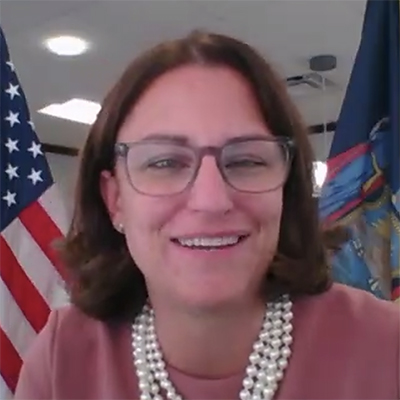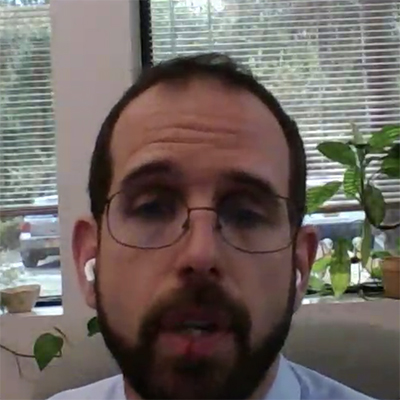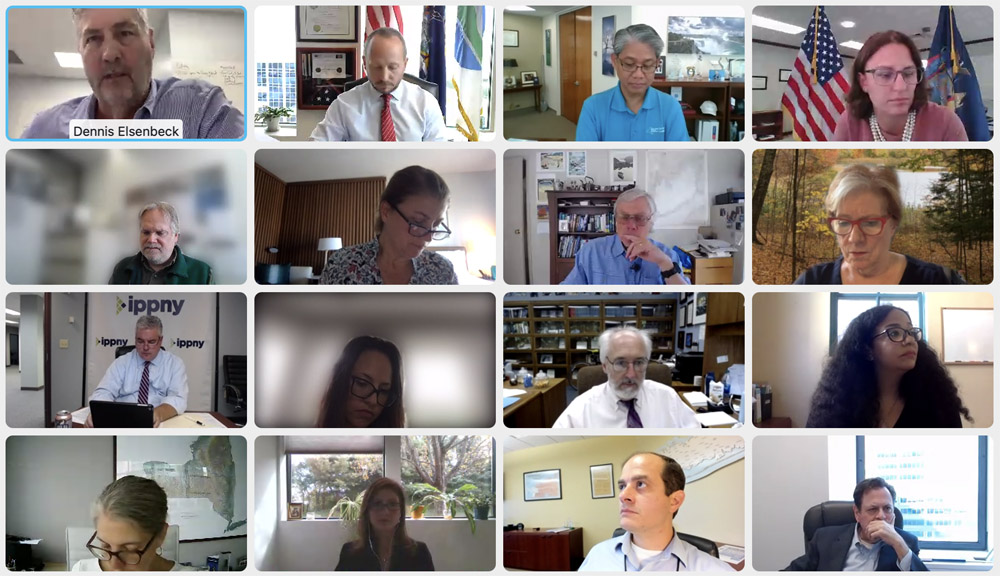
The New York State Climate Action Council met Thursday to discuss an integration analysis toward shaping its final scoping plan by year-end to help reach the environmental goals outlined in the state’s Climate Leadership and Community Protection Act (CLCPA).
 NYSERDA CEO Doreen Harris | NYDPS
NYSERDA CEO Doreen Harris | NYDPS“While we will see results based on a few key scenarios … these scenarios have been designed to bound the analysis and certainly not to set up an either-or situation where we pick our favorite scenario,” said Doreen Harris, CEO of the New York Energy Research and Development Authority (NYSERDA) and Council Co-chair.
The analysis provided by state agencies and consultancy Energy and Environmental Economics (E3) “is essentially yet another input and will provide an important point of reference as we head into 2022, and I fully expect that over the next year, once the draft scoping plan is issued, we will continue to discuss and debate the various strategies, challenges and tradeoffs that advance us to our goals,” Harris said.
The 22-member council aims to hold public meetings throughout 2022 before releasing a final plan in 2023.
Low-carbon Focus
The scenarios discussion focused on the strategic use of low-carbon fuels and an accelerated transition away from combustion.
 Carl Mas, NYSERDA | NYDPS
Carl Mas, NYSERDA | NYDPS“The strategic use of low-carbon fuels will achieve a system predominantly based on a grid that is wind, water and sunshine,” said Carl Mas, director of energy and environmental analysis at NYSERDA.
New York will have a heavily electrified system that includes strategic use of bioenergy, mostly derived from biogenic waste and agricultural residues, forest residues, and a limited amount of purpose-grown bioenergy as well as green hydrogen juxtaposed against that, Mas said.
The state is looking to limit and, in some cases, have no combustion, so no bioenergy combustion and no hydrogen switching to fuel cells where hydrogen might be used for long duration storage and the flow of new technologies that may come, he said.
“As a response we’ve had to accelerate our electrification and energy efficiency, so we’ll see how those play out both in terms of different health impacts and different cost structures,” Mas said. “We set the bar of trying to more comprehensively look at health than anyone has in the past, and I think we have succeeded.”
 Bob Howarth, Cornell University | NYDPS
Bob Howarth, Cornell University | NYDPSThe building sector is now getting closer to the 40% reduction in greenhouse gas emissions from 1990 levels that the CLCPA calls for by 2030, but transportation is still at around 27%, said Bob Howarth, professor of ecology and environmental biology at Cornell University. He asked what more the state can do to push that sector even harder.
Transportation takes more time partly because of where the sector is today, which is an actual increase since 1990 that’s unmatched in any other sector, Mas said.
“Our grid has gotten much cleaner since 1990,” Mas said. “Our buildings have actually gotten better over time, and transportation has gotten more efficient, but we’ve just been driving more, and we’ve been driving bigger, so there’s a higher mountain to climb for transportation.”
Building Stock Turnover
There could be a lot of things that need to change, and consumers need to have incentives to change, said Gavin Donohue, president and CEO of the Independent Power Producers of New York.
 IPPNY CEO Gavin Donohue | NYDPS
IPPNY CEO Gavin Donohue | NYDPSDoes the state believe that the models being put in place “are going to be adequate to make those consumer changes, or are we going to need a whole new suite of additional regulations and laws to make that change workable?” Donohue asked.
Mas turned the question back to the Council: “That’s what this deliberative body needs to discuss and debate. How are we going to do this and what structures do we have in place, and can we expand those existing structures?”
For electrifying the building sector, the state has a very gradual ramp-up and then a more accelerated path after 2025. That pathway represents about 5% per year of New York’s building stock of around 8 million households, but that is not the key statistic, Mas said.
New construction is really a small percent of the turnover of the “huge built environment,” he said, adding that retrofitting existing buildings is very important, and that usually happens when a building changes hands.
The model includes an assumption of the opportunity space and the opportunity timing, according to Mas.

“What you see predominantly happening for the first couple years is that any existing turnover of gas systems [for residential heating] is to a more efficient system, but pretty quickly by 2024-2025 we’re starting to see the bending of the gas curve as well,” Mas said.
It will be an efficient electrification process, Mas said. “So when you’re working with a customer, you’re not just necessarily only switching out a furnace, but taking that opportunity to also look at upgrades.”


